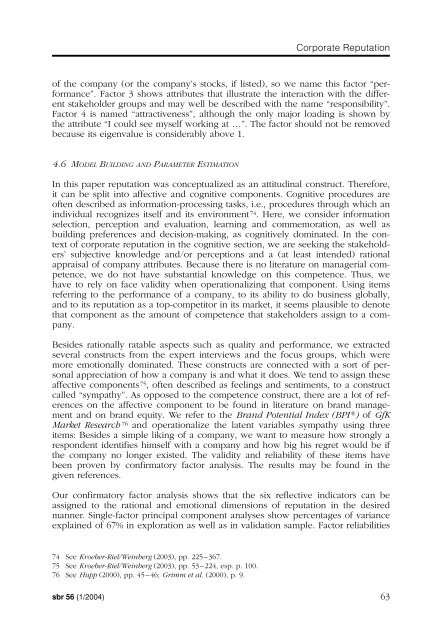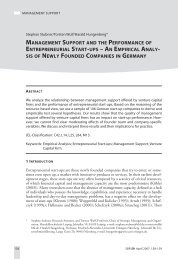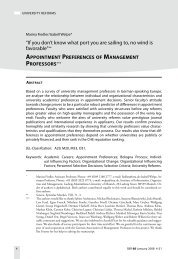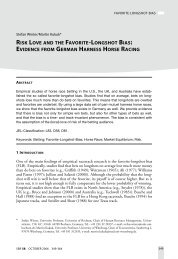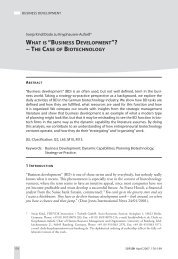components and parameters of corporate reputation - sbr ...
components and parameters of corporate reputation - sbr ...
components and parameters of corporate reputation - sbr ...
Create successful ePaper yourself
Turn your PDF publications into a flip-book with our unique Google optimized e-Paper software.
Corporate Reputation<br />
<strong>of</strong> the company (or the company’s stocks, if listed), so we name this factor “performance”.<br />
Factor 3 shows attributes that illustrate the interaction with the different<br />
stakeholder groups <strong>and</strong> may well be described with the name “responsibility”.<br />
Factor 4 is named “attractiveness”, although the only major loading is shown by<br />
the attribute “I could see myself working at …”. The factor should not be removed<br />
because its eigenvalue is considerably above 1.<br />
4.6 MODEL BUILDING AND PARAMETER ESTIMATION<br />
In this paper <strong>reputation</strong> was conceptualized as an attitudinal construct. Therefore,<br />
it can be split into affective <strong>and</strong> cognitive <strong>components</strong>. Cognitive procedures are<br />
<strong>of</strong>ten described as information-processing tasks, i.e., procedures through which an<br />
individual recognizes itself <strong>and</strong> its environment 74. Here, we consider information<br />
selection, perception <strong>and</strong> evaluation, learning <strong>and</strong> commemoration, as well as<br />
building preferences <strong>and</strong> decision-making, as cognitively dominated. In the context<br />
<strong>of</strong> <strong>corporate</strong> <strong>reputation</strong> in the cognitive section, we are seeking the stakeholders’<br />
subjective knowledge <strong>and</strong>/or perceptions <strong>and</strong> a (at least intended) rational<br />
appraisal <strong>of</strong> company attributes. Because there is no literature on managerial competence,<br />
we do not have substantial knowledge on this competence. Thus, we<br />
have to rely on face validity when operationalizing that component. Using items<br />
referring to the performance <strong>of</strong> a company, to its ability to do business globally,<br />
<strong>and</strong> to its <strong>reputation</strong> as a top-competitor in its market, it seems plausible to denote<br />
that component as the amount <strong>of</strong> competence that stakeholders assign to a company.<br />
Besides rationally ratable aspects such as quality <strong>and</strong> performance, we extracted<br />
several constructs from the expert interviews <strong>and</strong> the focus groups, which were<br />
more emotionally dominated. These constructs are connected with a sort <strong>of</strong> personal<br />
appreciation <strong>of</strong> how a company is <strong>and</strong> what it does. We tend to assign these<br />
affective <strong>components</strong> 75, <strong>of</strong>ten described as feelings <strong>and</strong> sentiments, to a construct<br />
called “sympathy”. As opposed to the competence construct, there are a lot <strong>of</strong> references<br />
on the affective component to be found in literature on br<strong>and</strong> management<br />
<strong>and</strong> on br<strong>and</strong> equity. We refer to the Br<strong>and</strong> Potential Index (BPI ® ) <strong>of</strong> GfK<br />
Market Research 76 <strong>and</strong> operationalize the latent variables sympathy using three<br />
items: Besides a simple liking <strong>of</strong> a company, we want to measure how strongly a<br />
respondent identifies himself with a company <strong>and</strong> how big his regret would be if<br />
the company no longer existed. The validity <strong>and</strong> reliability <strong>of</strong> these items have<br />
been proven by confirmatory factor analysis. The results may be found in the<br />
given references.<br />
Our confirmatory factor analysis shows that the six reflective indicators can be<br />
assigned to the rational <strong>and</strong> emotional dimensions <strong>of</strong> <strong>reputation</strong> in the desired<br />
manner. Single-factor principal component analyses show percentages <strong>of</strong> variance<br />
explained <strong>of</strong> 67% in exploration as well as in validation sample. Factor reliabilities<br />
74 See Kroeber-Riel/Weinberg (2003), pp. 225 – 367.<br />
75 See Kroeber-Riel/Weinberg (2003), pp. 53 – 224, esp. p. 100.<br />
76 See Hupp (2000), pp. 45 – 46; Grimm et al. (2000), p. 9.<br />
<strong>sbr</strong> 56 (1/2004) 63


